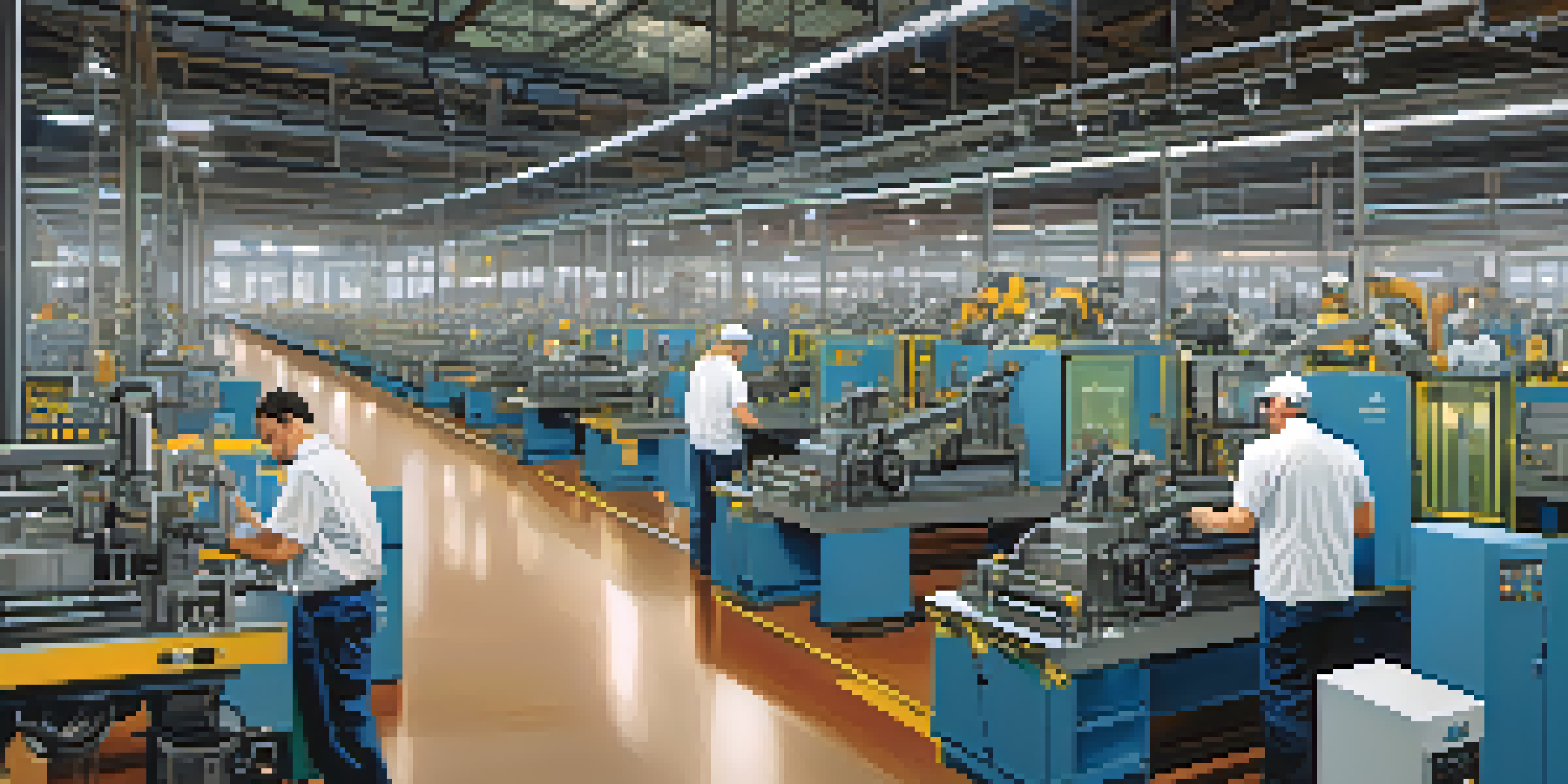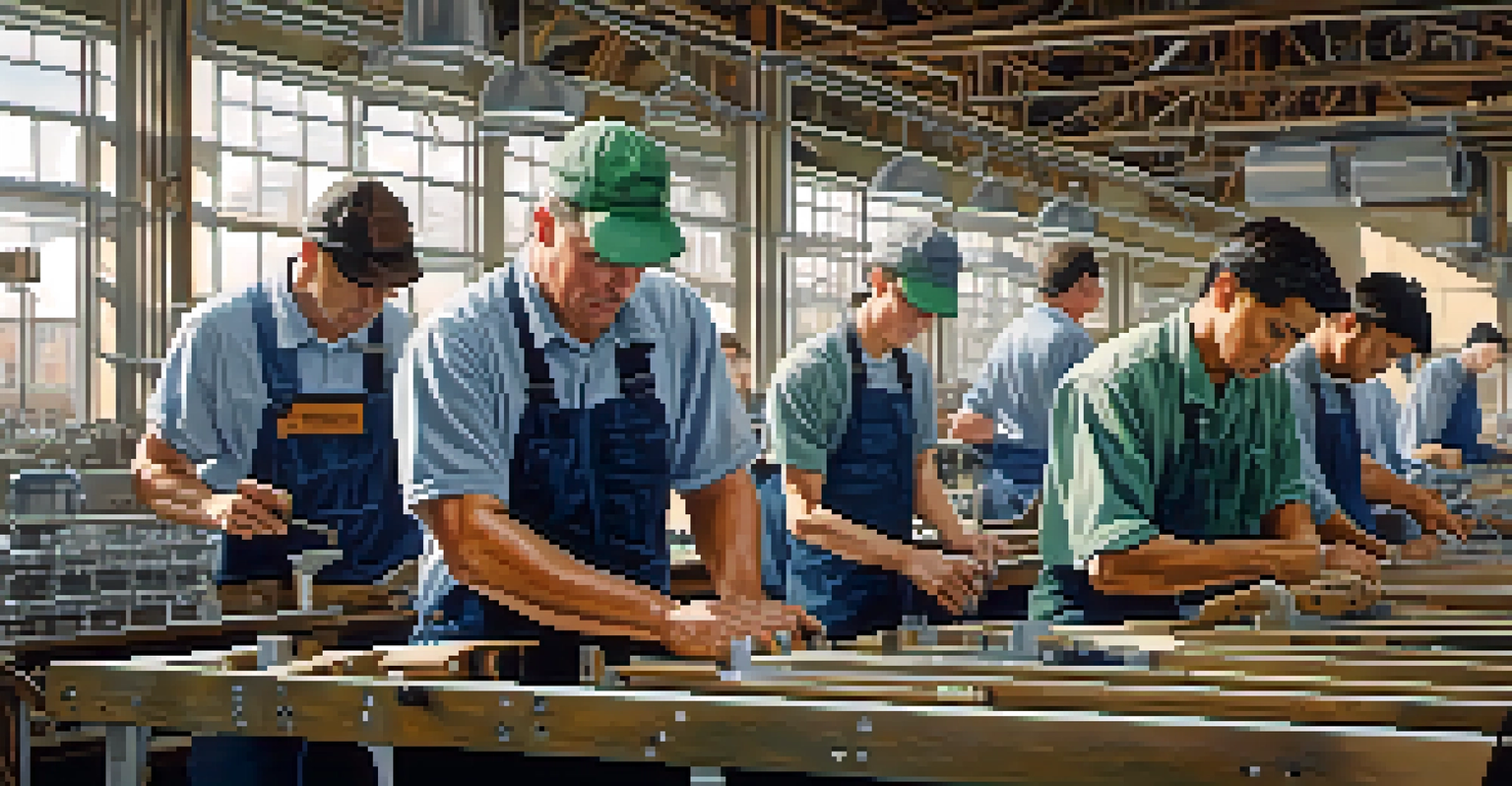The Role of Manufacturing in Buffalo's Economy Today

Understanding Buffalo's Manufacturing Heritage
Buffalo has a rich manufacturing history that dates back to the 19th century, becoming a hub for steel and grain production. This legacy has laid the groundwork for the city’s identity and economic framework. The manufacturing sector was once the backbone of the local economy, providing jobs and fostering community development. Today, this heritage is not just a memory; it influences modern manufacturing practices in the region.
Manufacturing is the backbone of our economy, providing jobs and fostering community development.
The city's transformation from heavy industry to a more diversified economy showcases its resilience. While manufacturing may not dominate as it once did, it remains a vital part of Buffalo’s economic fabric. New technologies and sustainability practices are now being integrated into traditional manufacturing processes, keeping the sector relevant and competitive.
In recent years, Buffalo has seen a resurgence in manufacturing, partly due to strategic investments and local initiatives. These efforts aim to modernize facilities and attract new industries, ensuring that Buffalo's manufacturing legacy continues to evolve. The blend of history and innovation is key to understanding the current landscape of manufacturing in Buffalo.
Current Manufacturing Trends in Buffalo
Today, Buffalo's manufacturing sector is witnessing significant changes, particularly with the rise of advanced manufacturing technologies. Automation, artificial intelligence, and 3D printing are revolutionizing how products are made, increasing efficiency and reducing costs. These advancements are not just about keeping up with global trends but also about positioning Buffalo as a leader in innovative manufacturing solutions.

Another important trend is the growing emphasis on sustainability within the manufacturing processes. Local companies are increasingly adopting eco-friendly practices, from waste reduction to energy-efficient production methods. This shift not only benefits the environment but also appeals to consumers who value corporate responsibility, thus creating a competitive edge for Buffalo's manufacturers.
Buffalo's Manufacturing Resurgence
Buffalo is experiencing a revival in manufacturing, driven by strategic investments and the integration of advanced technologies.
Furthermore, the skilled labor force in Buffalo plays a crucial role in supporting these manufacturing trends. Educational institutions and workforce development programs are focusing on equipping workers with the necessary skills to thrive in a modern manufacturing environment. This investment in human capital ensures that Buffalo can meet the demands of the evolving manufacturing landscape.
Manufacturing's Role in Job Creation
Manufacturing continues to be a significant source of employment in Buffalo, providing thousands of jobs across various sectors. From assembly lines to high-tech production facilities, these jobs are essential for the local economy. They not only offer competitive wages but also come with benefits that support families and communities.
Innovation distinguishes between a leader and a follower.
The revitalization of manufacturing in Buffalo has led to a surge in job creation, particularly in areas like advanced manufacturing and green technologies. Local initiatives have focused on attracting businesses that prioritize local hiring, thus strengthening the community. As new companies invest in Buffalo, they contribute to a more robust job market, enhancing the overall quality of life in the region.
Moreover, the collaboration between manufacturers and educational institutions has created pathways for students to enter the workforce. Internships and apprenticeship programs are helping to bridge the gap between education and employment, ensuring that the next generation is prepared for careers in manufacturing. This synergy is vital for sustaining job growth and economic stability in Buffalo.
The Impact of Manufacturing on Local Innovation
Manufacturing in Buffalo is not just about production; it’s also a catalyst for innovation. Local manufacturers are increasingly investing in research and development, leading to new products and processes. This focus on innovation helps to differentiate Buffalo’s manufacturing sector in a competitive marketplace.
Collaboration among businesses, universities, and research institutions has fostered a culture of innovation in the region. By sharing resources and expertise, these entities are pushing the boundaries of what’s possible in manufacturing. This collaborative spirit is essential for driving technological advancements and ensuring that Buffalo remains at the forefront of manufacturing innovation.
Sustainability in Manufacturing
Local manufacturers are increasingly adopting eco-friendly practices, enhancing their competitive edge and meeting consumer demands.
Additionally, the presence of startups and incubators in Buffalo is fueling the growth of new manufacturing ideas. Entrepreneurs are exploring niche markets and developing unique products that cater to specific consumer needs. This entrepreneurial energy not only stimulates the local economy but also reinforces Buffalo’s reputation as a hub for innovative manufacturing.
Challenges Facing Buffalo's Manufacturing Sector
Despite its successes, Buffalo's manufacturing sector faces several challenges that could impact its future growth. One major concern is the aging workforce, as many skilled workers are nearing retirement without enough younger workers to replace them. This demographic shift poses a risk to the continuity of skilled labor in the manufacturing industry.
Additionally, supply chain disruptions have become a pressing issue for manufacturers. The COVID-19 pandemic highlighted vulnerabilities in global supply chains, affecting everything from raw materials to shipping logistics. Buffalo manufacturers must find ways to adapt to these challenges to maintain production levels and meet consumer demands.
Finally, competition from other regions and countries is an ongoing challenge. Manufacturers in Buffalo must continuously innovate and improve their processes to stay competitive. This includes investing in technology and training, which can strain resources but is essential for long-term sustainability.
The Future of Manufacturing in Buffalo
Looking ahead, the future of manufacturing in Buffalo appears promising, driven by ongoing investments and strategic initiatives. Local leaders are committed to fostering a business environment that supports manufacturing growth, with incentives for innovation and sustainability. This proactive approach positions Buffalo as a competitive player in the manufacturing landscape.
Emerging technologies will continue to shape the manufacturing sector, with an emphasis on smart manufacturing systems that enhance efficiency and reduce waste. Buffalo’s manufacturers are poised to embrace these advancements, creating opportunities for growth and attracting new businesses to the area. The integration of technology into manufacturing processes will be pivotal in maintaining relevance in a rapidly changing market.
Challenges in Workforce and Supply
The manufacturing sector faces challenges such as an aging workforce and supply chain disruptions, which require innovative solutions to sustain growth.
Moreover, community engagement and support will play a crucial role in shaping the future of manufacturing in Buffalo. By fostering partnerships between businesses, educational institutions, and local governments, the region can create a cohesive strategy that drives manufacturing success. This collaborative effort will ensure that Buffalo remains a vibrant hub for manufacturing in the years to come.
Conclusion: Manufacturing's Enduring Influence on Buffalo
In conclusion, manufacturing remains a cornerstone of Buffalo's economy, shaping its past, present, and future. Despite facing challenges, the sector continues to adapt and thrive through innovation and community support. The rich manufacturing heritage of Buffalo serves as a foundation for ongoing growth and opportunity.
As the city embraces new technologies and sustainable practices, it is poised to emerge as a leader in advanced manufacturing. The collaboration between education and industry ensures that Buffalo will have the skilled workforce needed to sustain this growth. By nurturing this relationship, the community can build a resilient manufacturing sector that benefits all residents.

Ultimately, manufacturing's influence on Buffalo extends beyond the economy; it shapes the identity and character of the city. As Buffalo navigates its manufacturing journey, the commitment to innovation and collaboration will be key to unlocking its full potential in the years to come.